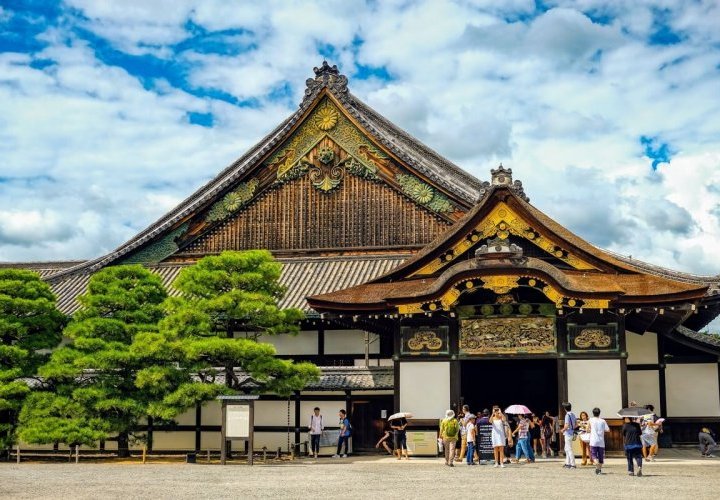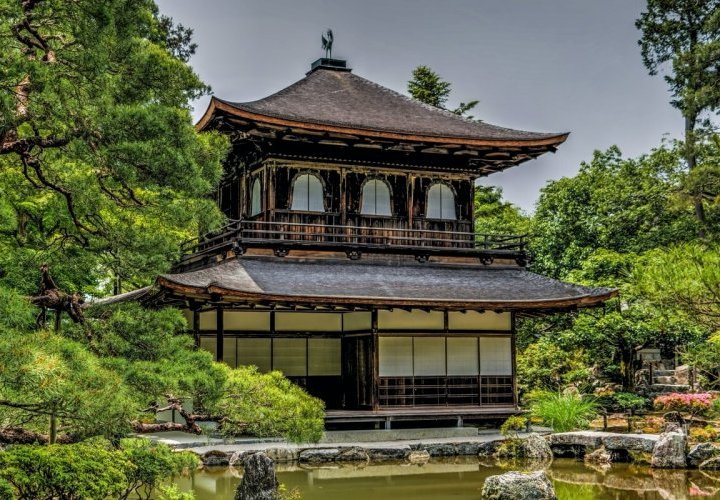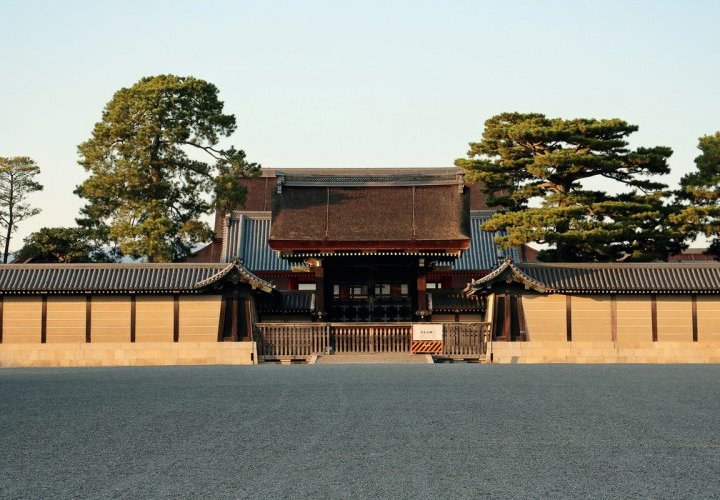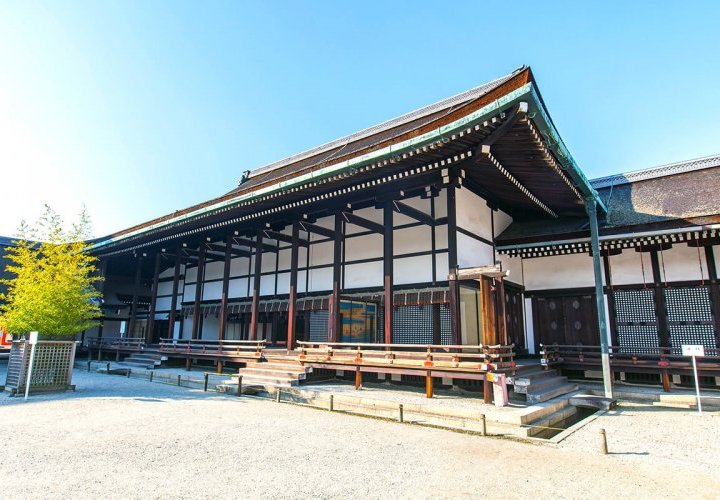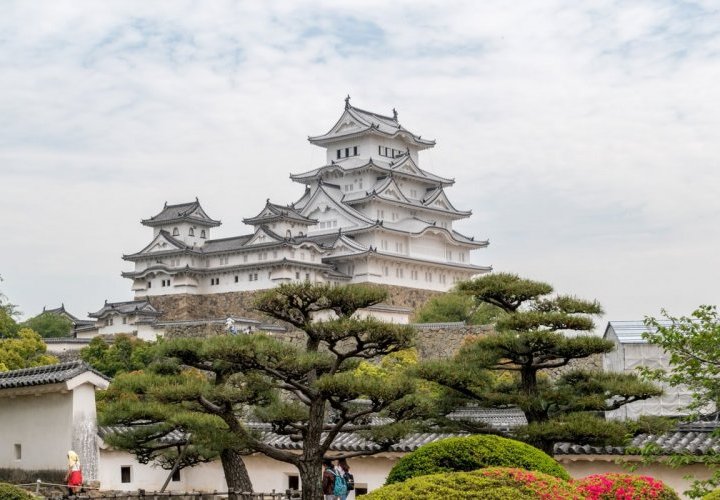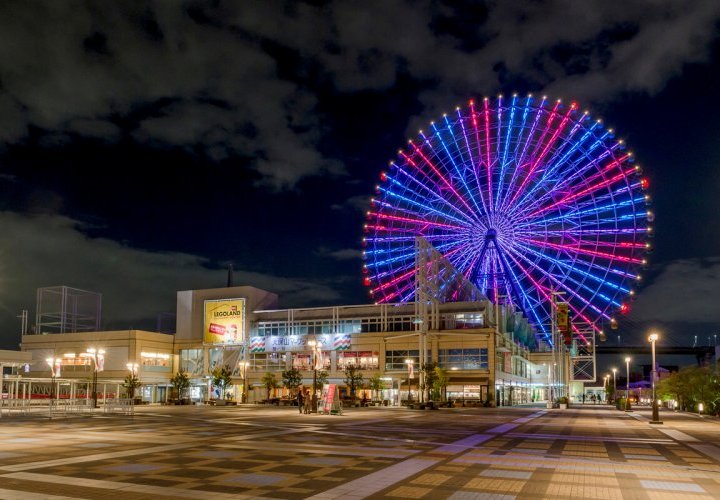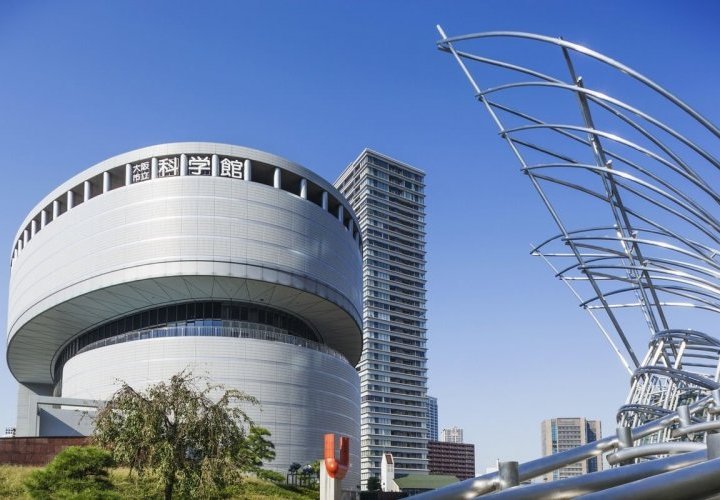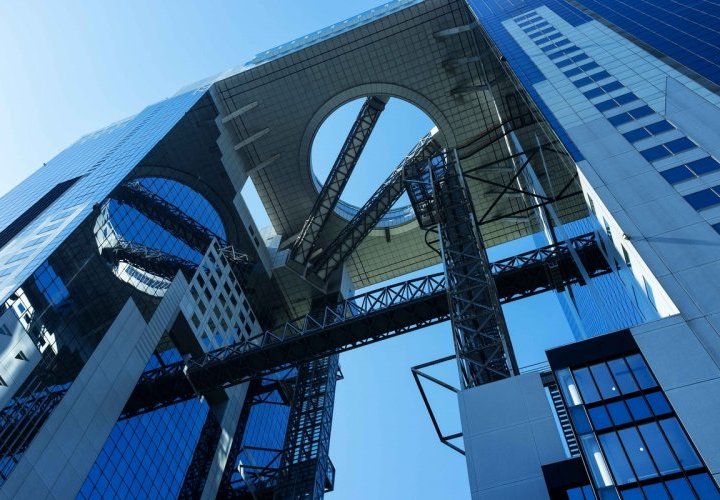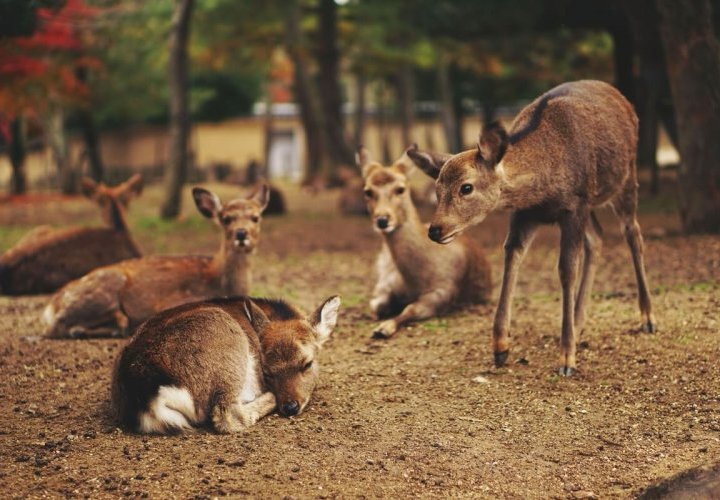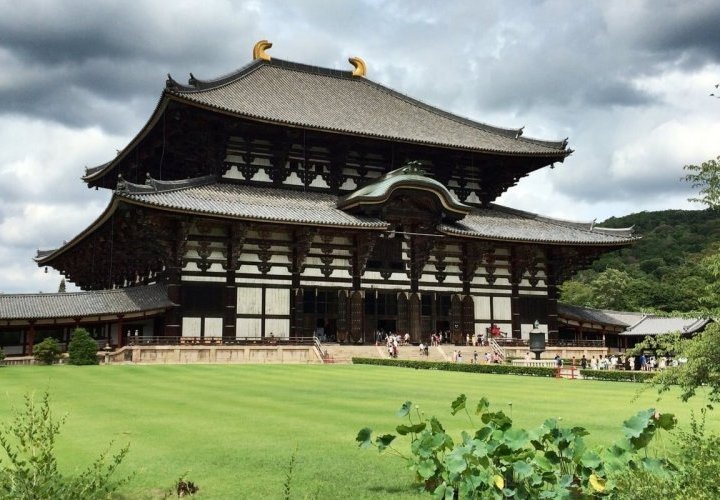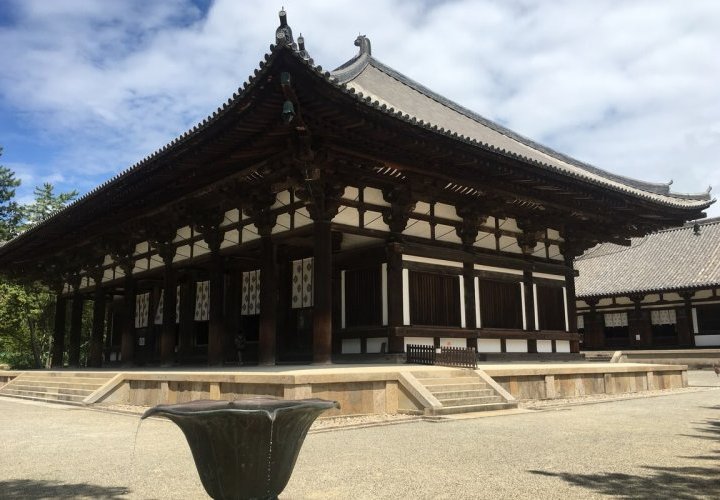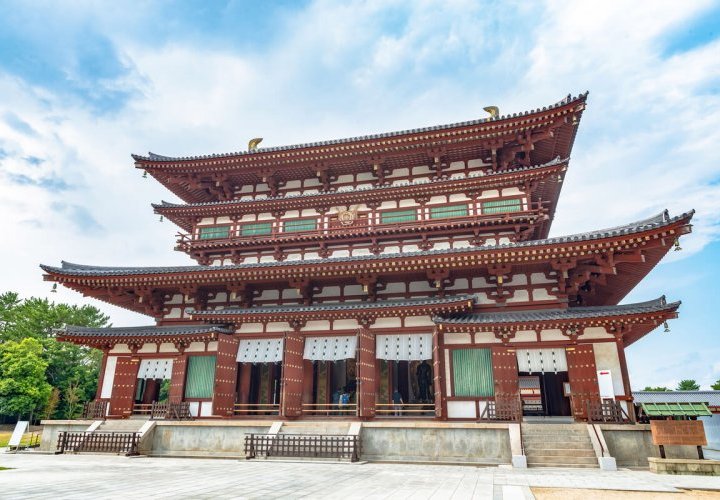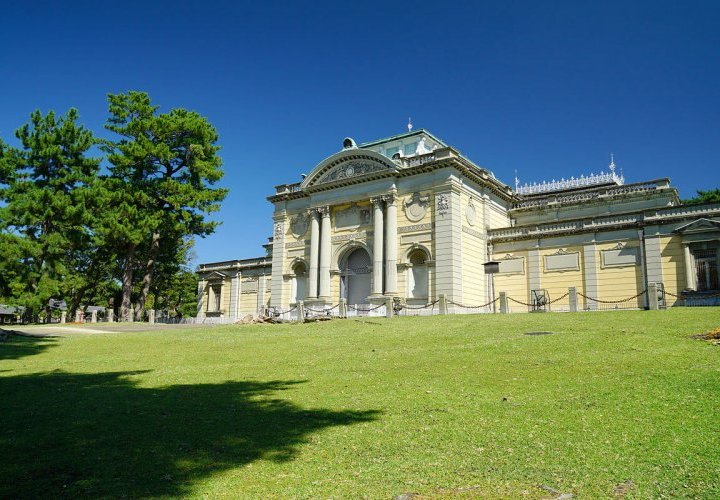Kansai region also known as Kinki region lies in the southern-central region of Honshu and encompasses the Osaka Plain with the cities of Osaka and Kyoto. It used to be the political and cultural centre of Japan for many centuries and includes seven prefectures: Mie, Nara, Wakayama, Kyoto, Osaka, Hyogo and Shiga. It is the historical heart of Japan having a population of around 22.7 million people. Keihanshin region encompassing the metropolitan areas of the cities of Kyoto, Osaka and Kobe is the second most populated in Japan after the Greater Tokyo Area.
The region is bordered by the Sea of Japan in the north, the Kii Peninsula and the Pacific Ocean to the south, and the Ibuki Mountains and Ise Bay to the east. It encompasses Lake Biwa, Japan’s largest freshwater lake and four of Japan’s national parks, more
The region is bordered by the Sea of Japan in the north, the Kii Peninsula and the Pacific Ocean to the south, and the Ibuki Mountains and Ise Bay to the east. It encompasses Lake Biwa, Japan’s largest freshwater lake and four of Japan’s national parks, more
which lie within its borders, completely or in part. Kansai region represents the focus of counterculture in Japan defined by the culture in Kyoto, the financial and economic flourishment in Osaka, the history of Nara and the cosmopolitanism of Kobe.
Kyoto is considered the cultural capital of Japan and served as capital and the emperor’s residence from 794 until 1868. It is a major destination in Japan and one of the country’s ten largest cities with a population of 1.5 million people. It is home to a number of Buddhist temples, Shinto shrines, palaces and gardens, and other historically priceless structures, many of which are listed collectively by UNESCO as a World Heritage Site. The modern city of Kyoto was established in 1889 and includes important attractions such as Kyoto Imperial Palace, Kiyomizudera, Kinkakuji, Ginkakuji, Katsura Imperial Villa and Kyoto University.
TOURIST ATTRACTIONS IN KYOTO
Nijo Castle
Nijo Castle was built in 1603 as the residence in Kyoto of Tokugawa Ieyasu, the first shogun of the Edo period (1603-1867) and was used as an imperial palace for a while. The castle’s palace buildings were completed 23 years later by his grandson Iemitsu who further expanded the castle by adding a five-story castle keep. Its palace buildings are by far the best surviving examples of castle palace architecture of Japan’s feudal era and several of them contain many significant works of art. The castle was designated a UNESCO World Heritage Site in 1994. Visitors to the castle enter the castle grounds through the castle’s East Gate (Higashi Otemon, its main entrance) and further reach the Inner Gate, or Karamon, notable for its fine carvings and decorated metalwork, in order to enter the Ninomaru, where the castle’s main attraction, Ninomaru Palace is located. The palace consists of five separate buildings linked by corridors and served as the residence and office of the shogun during his visits to Kyoto. The rooms feature elegantly decorated ceilings and beautifully painted sliding doors (fusuma).
Fushimi Inari Shrine
Fushimi Inari Shrine is an important Shinto shrine in southern Kyoto and a must-visit attraction when in Kyoto. The shrine was founded in AD 711 and is the most important of the thousands of shrines dedicated to Inari, the Shinto god of rice. The main building dates from 1499 and features a spectacular four-kilometre-long avenue of bright orange "torii" or arches, donations by individuals or companies (it takes around two hours to travel past the 32,000 arches lining the route). Also notable are its many sculptures of foxes, thought to be Inari’s messengers. While most foreign visitors come to Fushimi Inari Shrine mainly to explore the mountain trails, that lead into the wooded forest of the sacred Mount Inari, which stands at 233 metres and belongs to the shrine grounds, the shrine buildings themselves are also attractive.
Kinkakuji (Golden Pavilion) Temple
Kinkakuji is a Zen temple in northern Kyoto that was originally built in the 14th century as a retirement villa for Shogun Ashikaga Yoshimitsu. It is one of Kyoto’s most picturesque attractions and its top two floors are completely covered in gold leaf. Built over a large pond, the site is also famous for its beautiful grounds, as well as its old stone pagoda and the Sekkatei Teahouse added to Kinkakuji during the Edo period. For a different perspective of this wonderful site avoiding the summer, you can visit this site in autumn and admire the spectacular fall colours.
Ginkakuji (Silver Pavilion) Temple
Ginkakuji is a Zen temple along Kyoto’s eastern mountains (Higashiyama) that was originally built as a retirement villa in 1482 by Shogun Ashikaga Yoshimasa. He modelled it after Kinkakuji (Golden Pavilion), his grandfather’s retirement villa. This villa was converted into a Zen temple in 1490. Ginkakuji consists of the Silver Pavilion, other temple buildings, a beautiful moss garden and a unique dry sand garden that could be enjoyed by walking. Despite its name, the Silver Pavilion was never covered in silver and it is believed that the name was used to contrast it with the Golden Pavilion.
Kiyomizudera Temple
Kiyomizudera is one of the most celebrated temples of Japan and an important UNESCO World Heritage Site. It was founded in AD 780 in a picturesque location on Otowa Mountain overlooking the city of Kyoto and was dedicated to the 11-headed Kannon, the Buddhist Goddess of Mercy whose statue can be seen here. The existing buildings were built after 1633 in the period of the third Tokugawa Shogun, Iemitsu, and stand mainly on a rocky outcrop high above the Otowa Waterfall. Its name derives from the fall’s pure waters. Kiyomizudera is best known for the large terrace of the Main Hall, built on 30-metre-tall pillars with five rows of cross-beams and used as a stage for temple dances and ceremonies. The terrace affords spectacular views of the numerous cherry and maple trees as well as of the city of Kyoto.
Kyoto Imperial Palace
The original Kyoto Imperial Palace was built in AD 794 and was replaced several times after being destroyed by fire. It is one of the city’s most visited historic sites and used to be the residence of Japan’s Imperial Family until 1868, when the emperor and capital were moved from Kyoto to Tokyo. The current Imperial Palace was reconstructed in 1855 and is still impressive. The complex is enclosed by long walls and consists of several finely decorated gates, halls and gardens.
Nishi Honganji Temple
Nishi Honganji was built in 1591 by Toyotomi Hideyoshi and represents an outstanding example of Buddhist architecture. Rebuilt in 1760 it has two large structures: the Founder’s Hall, dedicated to Shinran, the sect's founder, and the Amidado Hall dedicated to the Amida Buddha, the most important Buddha in Jodo-Shin Buddhism. It includes a number of fine rooms decorated with paintings on gold backgrounds, and many important statues, some dating from the 6th century. Nishi Honganji was designated an UNESCO World Heritage Site. Also of interest is the Higashi Honganji built only eleven years after and a few street blocks east of Nishi Honganji and home to a number of examples of fine art work.
Kyoto National Museum
Kyoto National Museum opened in 1897 and it is one of the oldest and most distinguished museums of Japan. It is one of four top-level national museums and holds important artworks, archaeological relics, sculptures, ceramics, calligraphy, costumes and paintings. While focusing predominantly on pre-modern Asian art, particularly examples from Japan, the museum also includes a new wing designed by architect Yoshio Taniguchi and exhibits numerous examples of historic art and applied arts.
Gion
Gion district originally developed in the Sengoku period in front of Yasaka Shrine in order to accommodate the needs of travellers and visitors to the shrine. It further evolved to become the most famous geisha district of Kyoto and one of the most well-known geisha districts in all Japan. Here, you can see a multitude of shops, restaurants and ochaya (teahouses) where geiko (Kyoto dialect for geisha) and maiko (geiko apprentices) entertain people. It is a mix of modern architecture and historical beauty and is well suited to explore on foot. Gion attracts tourists with its high concentration of traditional wooden machiya merchant houses, well-preserved 17th-century restaurants and teahouses, many fine temples, in particular the 15th-century Silver Pavilion (Ginkakuji) and the Chion-in Temple. Many of machiya houses now operate as restaurants and serve Kyoto style kaiseki ryori (Japanese haute cuisine) and other types of local and international dishes.
Katsura Imperial Villa
Katsura Imperial Villa is one of the finest examples of Japanese architecture and garden design and was originally constructed in 1624 for Prince Hachijo Toshihito, brother of Emperor Goyozei. Designed by Kobori Enshu assisted by the prince, this beautiful garden is laid out in such a way that the visitor always sees things from the front. Smaller gardens are grouped around a large pond and the tour follows the circular walking trail around the central pond.
Daitokuji Temple
Daitokuji is a large walled Zen temple complex in northern Kyoto and one of the main temples of the Rinzai sect. It was founded in 1324 and is one of the best places in Japan to see a wide variety of Zen gardens and to experience Zen culture and architecture. Of the 22 buildings on-site, some are open to the public, including the Karamon, a Chinese-style gate with magnificent carvings. The main buildings of Daitokuji (the Sanmon Gate, Butsuden Hall, Hatto Hall and Hojo Residence) are not usually open to the public, but visitors may view into the interior of the Butsuden, the Main Hall.
SIDE TRIPS FROM KYOTO
Byodo-in Temple
Byodo-in Temple is a prominent example of Buddhist Pure Land (Jodo) architecture. It was initially built in AD 988 in Uji city as a countryside retreat villa for the powerful politician Fujiwara no Michinaga. His son turned Byodoin into a temple and ordered the construction of the Phoenix Hall, its most spectacular feature. The Phoenix Hall (Hoo-do) has two bronze phoenixes on its roof and houses the statue of the Amida Buddha inside it. The temple also boasts impressive paintings dating from the 11th-century, the Kannon-do Hall that is an important cultural property, the temple gardens with their many fine ponds, as well as the Byodo-in Museum with many treasures related to the temple site, including 52 wooden Buddha statues, carved phoenixes, and the original temple bell.
Himeji Castle
Himeji Castle is a hilltop Japanese castle located in Himeji city. It is the largest and most visited castle in Japan and is also considered to be the most beautiful surviving feudal castle in Japan. In 1993, Himeji Castle was registered as one of the first UNESCO World Heritage Sites in the country. The castle has a network of 83 rooms and is frequently known as Hakuro-jo or Shirasagi-jo (“White Egret Castle” or “White Heron Castle”) because of its brilliant white exterior. It is a must-see attraction in Japan and can be reached in less than one hour from Kyoto or Osaka.
Amanohashidate
Amanohashidate is a pine covered sandbar located in Miyazu Bay that was designed as one of Japan’s three scenic views. The sandbar is 3.3 km long and is covered with about 7,000 pine trees. It can be viewed from the mountains on either side of the bay or it can be explored on foot or by rental bicycle at either end of the sandbar. Several attractions such as temples, shrines, a small amusement park and observation decks from which to enjoy the view can be explored. You can also enjoy a sightseeing cruise or the sand beaches along the sandbar.
Kyoto is considered the cultural capital of Japan and served as capital and the emperor’s residence from 794 until 1868. It is a major destination in Japan and one of the country’s ten largest cities with a population of 1.5 million people. It is home to a number of Buddhist temples, Shinto shrines, palaces and gardens, and other historically priceless structures, many of which are listed collectively by UNESCO as a World Heritage Site. The modern city of Kyoto was established in 1889 and includes important attractions such as Kyoto Imperial Palace, Kiyomizudera, Kinkakuji, Ginkakuji, Katsura Imperial Villa and Kyoto University.
TOURIST ATTRACTIONS IN KYOTO
Nijo Castle
Nijo Castle was built in 1603 as the residence in Kyoto of Tokugawa Ieyasu, the first shogun of the Edo period (1603-1867) and was used as an imperial palace for a while. The castle’s palace buildings were completed 23 years later by his grandson Iemitsu who further expanded the castle by adding a five-story castle keep. Its palace buildings are by far the best surviving examples of castle palace architecture of Japan’s feudal era and several of them contain many significant works of art. The castle was designated a UNESCO World Heritage Site in 1994. Visitors to the castle enter the castle grounds through the castle’s East Gate (Higashi Otemon, its main entrance) and further reach the Inner Gate, or Karamon, notable for its fine carvings and decorated metalwork, in order to enter the Ninomaru, where the castle’s main attraction, Ninomaru Palace is located. The palace consists of five separate buildings linked by corridors and served as the residence and office of the shogun during his visits to Kyoto. The rooms feature elegantly decorated ceilings and beautifully painted sliding doors (fusuma).
Fushimi Inari Shrine
Fushimi Inari Shrine is an important Shinto shrine in southern Kyoto and a must-visit attraction when in Kyoto. The shrine was founded in AD 711 and is the most important of the thousands of shrines dedicated to Inari, the Shinto god of rice. The main building dates from 1499 and features a spectacular four-kilometre-long avenue of bright orange "torii" or arches, donations by individuals or companies (it takes around two hours to travel past the 32,000 arches lining the route). Also notable are its many sculptures of foxes, thought to be Inari’s messengers. While most foreign visitors come to Fushimi Inari Shrine mainly to explore the mountain trails, that lead into the wooded forest of the sacred Mount Inari, which stands at 233 metres and belongs to the shrine grounds, the shrine buildings themselves are also attractive.
Kinkakuji (Golden Pavilion) Temple
Kinkakuji is a Zen temple in northern Kyoto that was originally built in the 14th century as a retirement villa for Shogun Ashikaga Yoshimitsu. It is one of Kyoto’s most picturesque attractions and its top two floors are completely covered in gold leaf. Built over a large pond, the site is also famous for its beautiful grounds, as well as its old stone pagoda and the Sekkatei Teahouse added to Kinkakuji during the Edo period. For a different perspective of this wonderful site avoiding the summer, you can visit this site in autumn and admire the spectacular fall colours.
Ginkakuji (Silver Pavilion) Temple
Ginkakuji is a Zen temple along Kyoto’s eastern mountains (Higashiyama) that was originally built as a retirement villa in 1482 by Shogun Ashikaga Yoshimasa. He modelled it after Kinkakuji (Golden Pavilion), his grandfather’s retirement villa. This villa was converted into a Zen temple in 1490. Ginkakuji consists of the Silver Pavilion, other temple buildings, a beautiful moss garden and a unique dry sand garden that could be enjoyed by walking. Despite its name, the Silver Pavilion was never covered in silver and it is believed that the name was used to contrast it with the Golden Pavilion.
Kiyomizudera Temple
Kiyomizudera is one of the most celebrated temples of Japan and an important UNESCO World Heritage Site. It was founded in AD 780 in a picturesque location on Otowa Mountain overlooking the city of Kyoto and was dedicated to the 11-headed Kannon, the Buddhist Goddess of Mercy whose statue can be seen here. The existing buildings were built after 1633 in the period of the third Tokugawa Shogun, Iemitsu, and stand mainly on a rocky outcrop high above the Otowa Waterfall. Its name derives from the fall’s pure waters. Kiyomizudera is best known for the large terrace of the Main Hall, built on 30-metre-tall pillars with five rows of cross-beams and used as a stage for temple dances and ceremonies. The terrace affords spectacular views of the numerous cherry and maple trees as well as of the city of Kyoto.
Kyoto Imperial Palace
The original Kyoto Imperial Palace was built in AD 794 and was replaced several times after being destroyed by fire. It is one of the city’s most visited historic sites and used to be the residence of Japan’s Imperial Family until 1868, when the emperor and capital were moved from Kyoto to Tokyo. The current Imperial Palace was reconstructed in 1855 and is still impressive. The complex is enclosed by long walls and consists of several finely decorated gates, halls and gardens.
Nishi Honganji Temple
Nishi Honganji was built in 1591 by Toyotomi Hideyoshi and represents an outstanding example of Buddhist architecture. Rebuilt in 1760 it has two large structures: the Founder’s Hall, dedicated to Shinran, the sect's founder, and the Amidado Hall dedicated to the Amida Buddha, the most important Buddha in Jodo-Shin Buddhism. It includes a number of fine rooms decorated with paintings on gold backgrounds, and many important statues, some dating from the 6th century. Nishi Honganji was designated an UNESCO World Heritage Site. Also of interest is the Higashi Honganji built only eleven years after and a few street blocks east of Nishi Honganji and home to a number of examples of fine art work.
Kyoto National Museum
Kyoto National Museum opened in 1897 and it is one of the oldest and most distinguished museums of Japan. It is one of four top-level national museums and holds important artworks, archaeological relics, sculptures, ceramics, calligraphy, costumes and paintings. While focusing predominantly on pre-modern Asian art, particularly examples from Japan, the museum also includes a new wing designed by architect Yoshio Taniguchi and exhibits numerous examples of historic art and applied arts.
Gion
Gion district originally developed in the Sengoku period in front of Yasaka Shrine in order to accommodate the needs of travellers and visitors to the shrine. It further evolved to become the most famous geisha district of Kyoto and one of the most well-known geisha districts in all Japan. Here, you can see a multitude of shops, restaurants and ochaya (teahouses) where geiko (Kyoto dialect for geisha) and maiko (geiko apprentices) entertain people. It is a mix of modern architecture and historical beauty and is well suited to explore on foot. Gion attracts tourists with its high concentration of traditional wooden machiya merchant houses, well-preserved 17th-century restaurants and teahouses, many fine temples, in particular the 15th-century Silver Pavilion (Ginkakuji) and the Chion-in Temple. Many of machiya houses now operate as restaurants and serve Kyoto style kaiseki ryori (Japanese haute cuisine) and other types of local and international dishes.
Katsura Imperial Villa
Katsura Imperial Villa is one of the finest examples of Japanese architecture and garden design and was originally constructed in 1624 for Prince Hachijo Toshihito, brother of Emperor Goyozei. Designed by Kobori Enshu assisted by the prince, this beautiful garden is laid out in such a way that the visitor always sees things from the front. Smaller gardens are grouped around a large pond and the tour follows the circular walking trail around the central pond.
Daitokuji Temple
Daitokuji is a large walled Zen temple complex in northern Kyoto and one of the main temples of the Rinzai sect. It was founded in 1324 and is one of the best places in Japan to see a wide variety of Zen gardens and to experience Zen culture and architecture. Of the 22 buildings on-site, some are open to the public, including the Karamon, a Chinese-style gate with magnificent carvings. The main buildings of Daitokuji (the Sanmon Gate, Butsuden Hall, Hatto Hall and Hojo Residence) are not usually open to the public, but visitors may view into the interior of the Butsuden, the Main Hall.
SIDE TRIPS FROM KYOTO
Byodo-in Temple
Byodo-in Temple is a prominent example of Buddhist Pure Land (Jodo) architecture. It was initially built in AD 988 in Uji city as a countryside retreat villa for the powerful politician Fujiwara no Michinaga. His son turned Byodoin into a temple and ordered the construction of the Phoenix Hall, its most spectacular feature. The Phoenix Hall (Hoo-do) has two bronze phoenixes on its roof and houses the statue of the Amida Buddha inside it. The temple also boasts impressive paintings dating from the 11th-century, the Kannon-do Hall that is an important cultural property, the temple gardens with their many fine ponds, as well as the Byodo-in Museum with many treasures related to the temple site, including 52 wooden Buddha statues, carved phoenixes, and the original temple bell.
Himeji Castle
Himeji Castle is a hilltop Japanese castle located in Himeji city. It is the largest and most visited castle in Japan and is also considered to be the most beautiful surviving feudal castle in Japan. In 1993, Himeji Castle was registered as one of the first UNESCO World Heritage Sites in the country. The castle has a network of 83 rooms and is frequently known as Hakuro-jo or Shirasagi-jo (“White Egret Castle” or “White Heron Castle”) because of its brilliant white exterior. It is a must-see attraction in Japan and can be reached in less than one hour from Kyoto or Osaka.
Amanohashidate
Amanohashidate is a pine covered sandbar located in Miyazu Bay that was designed as one of Japan’s three scenic views. The sandbar is 3.3 km long and is covered with about 7,000 pine trees. It can be viewed from the mountains on either side of the bay or it can be explored on foot or by rental bicycle at either end of the sandbar. Several attractions such as temples, shrines, a small amusement park and observation decks from which to enjoy the view can be explored. You can also enjoy a sightseeing cruise or the sand beaches along the sandbar.
Osaka is the second largest metropolitan area of Japan after Tokyo and has flourished as the economic hub of Kansai region for many centuries. It had developed into an important regional port by the Kofun period (300–538), served briefly as the imperial capital in the 7th and 8th centuries and became known as a centre of Japanese culture during the Edo period (1603–1867). Currently, it is a major financial centre of Japan home to Osaka Securities Exchange as well as the multinational electronics corporations Panasonic and Sharp.
TOURIST ATTRACTIONS IN OSAKA
Osaka Castle
The construction of Osaka Castle started in 1583 and finished in 1586 in just three years. It was built at the order of the Japanese warrior and politician Toyotomi Hideyoshi being, more
TOURIST ATTRACTIONS IN OSAKA
Osaka Castle
The construction of Osaka Castle started in 1583 and finished in 1586 in just three years. It was built at the order of the Japanese warrior and politician Toyotomi Hideyoshi being, more
at the time, the largest castle in Japan. In 1615, Tokugawa troops attacked and destroyed the castle, but it was rebuilt by Tokugawa Hidetada in the 1620s for reasons of prestige. Again destroyed after the fall of the Shogunate, the castle was reconstructed in its current form in 1931. The castle complex includes the five-story 42-metre-tall main tower that contains a great informative museum about the castle’s history and Hokoku Shrine located in Osaka Castle Park (about 2 square kilometres) and dedicated to Hideyoshi and his family. The park is one of the most popular hanami spots in Osaka during the cherry blossom season, which usually takes place in early April.
Shitennoji Temple
Shitennoji is one of Japan’s oldest temples and was the first Buddhist temple of Japan. It was founded in 593 by Prince Shotoku and remains the oldest such religious site to be officially administered. Although the temple was rebuilt many times through the centuries, the reconstruction process was carried out carefully in order to reflect the original 6th century design. On the territory of the temple, you can visit the site’s five-story pagoda along with the Golden Pavilion (Kondo) with its fine statues and paintings, the Lecture Hall (Kodo), and the Gokuraku-jodo Garden designed according to the descriptions of the Western Paradise of the Amida Buddha.
Osaka Aquarium Kaiyukan
Osaka Aquarium Kaiyukan is one of the world’s biggest such attractions and looks like as if it was made of giant Lego blocks. This walk-through aquarium takes guests on a fascinating tour showing various forms of marine life displayed in 15 tanks, each representing a specific region of the Pacific Rim. The biggest tank is the central tank being nine metres deep and representing the Pacific Ocean.
Tempozan Giant Ferris Wheel
Providing some of the best views over Osaka, Tempozan Giant Ferris Wheel located just outside of the aquarium is one of the largest such attractions in Asia. Although it is ironically named after Japan’s smallest mountain, the Tempozan Giant Ferris Wheel stands at 112.5 metres high and has a diameter spanning 100 metres. It offers a thrilling 17-minute journey during which you can admire many landmarks, especially the port area and the Tempozan Harbor Village in which it is located.
National Museum of Art
The National Museum of Art of Osaka is a unique underground art museum that occupies two underground floors on Nakanoshima Island in central Osaka. Opened in 1977, the museum focuses on Japanese and foreign contemporary art, containing a large collection of some of the leading international artists such as Picasso and Cézanne and Japanese artists Kuniyoshi and Foujita. According to the architect, César Pelli, the current building of the museum, opened in 2004, was designed to resemble reeds along a riverbank or arching stalks of a bamboo grove. Currently, the museum houses 6,109 works which include graphic design works, prints, sculptures, craftworks, sketches, photographs, oil paintings, “Nihonga” style Japanese paintings, etc.
Osaka Science Museum
Designed with children in mind, Osaka Science Museum offers an educational experience for children and takes visitors through displays on the universe, chemistry, electricity and energy. Opened in 1989 above the National Museum of Art, the museum has four floors of hands-on and interactive exhibits and displays. Osaka Science Museum boasts the country’s first planetarium with hourly shows.
Umeda Sky Building
Osaka boasts many other fine examples of modern architecture and one of them is the Umeda Sky Building - a spectacular high rise building in Kita district of Osaka, near Osaka and Umeda Stations. It consists of two office towers joined at the top by the rooftop “Floating Garden Observatory” on the 39th floor. The observatory offers spectacular views of the city through its windows and from its open-air deck.
Shitennoji Temple
Shitennoji is one of Japan’s oldest temples and was the first Buddhist temple of Japan. It was founded in 593 by Prince Shotoku and remains the oldest such religious site to be officially administered. Although the temple was rebuilt many times through the centuries, the reconstruction process was carried out carefully in order to reflect the original 6th century design. On the territory of the temple, you can visit the site’s five-story pagoda along with the Golden Pavilion (Kondo) with its fine statues and paintings, the Lecture Hall (Kodo), and the Gokuraku-jodo Garden designed according to the descriptions of the Western Paradise of the Amida Buddha.
Osaka Aquarium Kaiyukan
Osaka Aquarium Kaiyukan is one of the world’s biggest such attractions and looks like as if it was made of giant Lego blocks. This walk-through aquarium takes guests on a fascinating tour showing various forms of marine life displayed in 15 tanks, each representing a specific region of the Pacific Rim. The biggest tank is the central tank being nine metres deep and representing the Pacific Ocean.
Tempozan Giant Ferris Wheel
Providing some of the best views over Osaka, Tempozan Giant Ferris Wheel located just outside of the aquarium is one of the largest such attractions in Asia. Although it is ironically named after Japan’s smallest mountain, the Tempozan Giant Ferris Wheel stands at 112.5 metres high and has a diameter spanning 100 metres. It offers a thrilling 17-minute journey during which you can admire many landmarks, especially the port area and the Tempozan Harbor Village in which it is located.
National Museum of Art
The National Museum of Art of Osaka is a unique underground art museum that occupies two underground floors on Nakanoshima Island in central Osaka. Opened in 1977, the museum focuses on Japanese and foreign contemporary art, containing a large collection of some of the leading international artists such as Picasso and Cézanne and Japanese artists Kuniyoshi and Foujita. According to the architect, César Pelli, the current building of the museum, opened in 2004, was designed to resemble reeds along a riverbank or arching stalks of a bamboo grove. Currently, the museum houses 6,109 works which include graphic design works, prints, sculptures, craftworks, sketches, photographs, oil paintings, “Nihonga” style Japanese paintings, etc.
Osaka Science Museum
Designed with children in mind, Osaka Science Museum offers an educational experience for children and takes visitors through displays on the universe, chemistry, electricity and energy. Opened in 1989 above the National Museum of Art, the museum has four floors of hands-on and interactive exhibits and displays. Osaka Science Museum boasts the country’s first planetarium with hourly shows.
Umeda Sky Building
Osaka boasts many other fine examples of modern architecture and one of them is the Umeda Sky Building - a spectacular high rise building in Kita district of Osaka, near Osaka and Umeda Stations. It consists of two office towers joined at the top by the rooftop “Floating Garden Observatory” on the 39th floor. The observatory offers spectacular views of the city through its windows and from its open-air deck.
The first permanent capital of Japan was established in AD 710 at Heijo, the city now known as Nara. Because the influence and political ambitions of the powerful Buddhist monasteries in the city became a serious threat to the government, the capital was moved from Nara to Nagaoka in AD 784.
The city is located less than one hour from Kyoto and Osaka and occupies the northern part of Nara Prefecture. Due to its past as the first permanent capital, Nara remains full of historic treasures including the eight sites: Todaiji, Kofukuji, Kasuga Taisha Shrine, Gangoji, Yakushiji, Toshodaiji, Heijo Palace and Kasugayama Primeval Forest, that collectively form the “Historic Monuments of Ancient Nara”, a UNESCO World Heritage Site.
TOURIST ATTRACTIONS IN NARA
Nara Park
Located in the heart of the city, more
The city is located less than one hour from Kyoto and Osaka and occupies the northern part of Nara Prefecture. Due to its past as the first permanent capital, Nara remains full of historic treasures including the eight sites: Todaiji, Kofukuji, Kasuga Taisha Shrine, Gangoji, Yakushiji, Toshodaiji, Heijo Palace and Kasugayama Primeval Forest, that collectively form the “Historic Monuments of Ancient Nara”, a UNESCO World Heritage Site.
TOURIST ATTRACTIONS IN NARA
Nara Park
Located in the heart of the city, more
Nara Park was established in 1880 and is home to many attractions including Todaiji Temple, Kasuga Taisha Shrine, Kofukuji Temple adjacent to the large Sarusawa Pond and Nara National Museum. It is also home to over 1,000 freely roaming deer that became a symbol of the city and have even been designated as a natural treasure.
Todaiji Temple
Located in Nara Park, the eighth-century Todaiji (Great East Temple) is the most famous of the Seven Great Temples of Nara. The temple was built in 738 as the head temple of all provincial Buddhist temples of Japan. It opened in 752 AD and became so powerful that the capital was moved from Nara to Nagaoka in 784 in order to lower the influence of the temple on government affairs. Todaiji’s main hall, the Daibutsuden (Big Buddha Hall), houses one of the world’s largest bronze statue of the Great Buddha known in Japanese as Daibutsu (15 m). Along the approach to Todaiji stands the Nandaimon Gate, a large wooden gate watched over by two Nio statues standing eight metres tall representing the Nio Guardian Kings that were designated national treasures together with the gate itself. The temple was declared a UNESCO World Heritage Site as one of the “Historic Monuments of Ancient Nara”, together with other sites in the city of Nara.
Kofukuji Temple
Another temple of the Seven Great Temples of Nara also in Nara Park, Kofukuji used to be the family temple of the Fujiwara, the most powerful aristocratic clan during much of the Nara and Heian Periods. Kofukuji Temple was established in Nara at the same time as the capital (710) and the temple complex included 175 buildings in its heyday. The temple has several buildings of great historic value, including a five-story pagoda (at 50 m it is Japan’s second tallest wooden pagoda), a three-story pagoda, Northern and Southern Octagonal Halls, the Central Golden Hall, the Eastern Golden Hall and Kofukuji’s National Treasure Museum. The museum is an absolute must-see for lovers of Buddhist art including the three-faced, six-armed Ashura Statue among its exhibits, one of the most celebrated Buddhist statues in all of Japan.
Toshodaiji Temple
Toshodaiji was built in AD 759 as the main temple of the 30 temples of the Ritsu sect and is currently one of the places in Nara designated by UNESCO a World Heritage Site as part of the “Historic Monuments of Ancient Nara”. It was founded by Ganjin, a Chinese monk who was invited to Japan by the emperor in order to train priests and improve Japanese Buddhism. The Main Hall (Kondo) represents a fine example of Tempyo architecture and is popular for its vast pillared gallery and large seated statue of Rushana-butsu and its magnificent halo decorated with 864 small Buddhas. The Lecture Hall (Kodo) was originally an administrative building located in the Nara Imperial Palace and contains many fine sculptures.
Yakushiji Temple
Yakushiji Temple was built by Emperor Tenmu in the 7th century and still contains statues from that period. It is one of Japan’s oldest temples and the main temple of the Hosso sect of Japanese Buddhism. Yakushiji has a strictly symmetric layout, with the Main Hall (Kondo) containing the famous Yakushi Trinity and Lecture Hall standing on a central axis, flanked by two pagodas. The original three-story East Pagoda, standing 38 metres high is the only structure that survived along the years representing an example of Buddhist architecture of the seventh century. Behind the pagoda is the East Hall that was built in 1285 containing a two-metre-high bronze figure of Sho-Kannon, a gift from the King of Paekche (Korea).
Kasuga Taisha Shrine
Kasuga Taisha Shrine was founded by Fujiwara Nagate in AD 768 being rebuilt several times over the centuries. It consists of several separate buildings that are examples of the Kasuga-zukuri style, characterized by the curving roofline, brightly painted red beams and the white facing of the walls. Another distinguishing feature are the many hundreds of bronze that embellish the interior, as well as the stone lanterns, that lead up the shrine. They are lit each February and August during special Lantern Festivals. Near the shrine is the Kasugayama Primeval Forest, a beautiful reserve known for its rare birds, trees, and wildlife. Kasuga Taisha Shrine, as well as the Kasugayama Primeval Forest are registered as a UNESCO World Heritage Site as part of the “Historic Monuments of Ancient Nara”.
Nara National Museum
Nara National Museum was built in 1889 and displays numerous major works of art, particularly Japanese Buddhist art. The original building, which is a representative Western-style building of the Meiji period was designed by Katayama Tokuma and is an Important Cultural Property in Japan. Later, in 1973, Junzo Yoshimura designed an additional building, a new wing connected to the original building by an underground passage. The permanent collection of the museum includes a number of galleries dedicated to archaeological finds, as well as fine displays of sculpture, paintings, and calligraphy including numerous Buddhist statues and paintings.
Horyuji Temple
Horyuji is the oldest completely preserved temples in Japan, containing the world’s oldest surviving wooden structures. It was founded in AD 607 by Prince Shotoku and represents a magnificent example of the architecture from the Asuka period AD 552-645. As the main temple of the Shotoku sect, the site comprises 45 buildings and was designated a UNESCO World Heritage Site in 1993. The temple’s grounds are spacious and separated into two main precincts, the Western Precinct (Saiin Garan) with 31 buildings, and the Eastern Precinct (Toin Garan) with 14 buildings. The Western Precinct is enclosed by roofed corridors and is home to the Central Gate (Chumon), the Main Hall (Kondo) and a five-story pagoda built in the Asuka Period. They have not suffered destruction since then, although they have undergone renovations multiple times over the centuries.
Todaiji Temple
Located in Nara Park, the eighth-century Todaiji (Great East Temple) is the most famous of the Seven Great Temples of Nara. The temple was built in 738 as the head temple of all provincial Buddhist temples of Japan. It opened in 752 AD and became so powerful that the capital was moved from Nara to Nagaoka in 784 in order to lower the influence of the temple on government affairs. Todaiji’s main hall, the Daibutsuden (Big Buddha Hall), houses one of the world’s largest bronze statue of the Great Buddha known in Japanese as Daibutsu (15 m). Along the approach to Todaiji stands the Nandaimon Gate, a large wooden gate watched over by two Nio statues standing eight metres tall representing the Nio Guardian Kings that were designated national treasures together with the gate itself. The temple was declared a UNESCO World Heritage Site as one of the “Historic Monuments of Ancient Nara”, together with other sites in the city of Nara.
Kofukuji Temple
Another temple of the Seven Great Temples of Nara also in Nara Park, Kofukuji used to be the family temple of the Fujiwara, the most powerful aristocratic clan during much of the Nara and Heian Periods. Kofukuji Temple was established in Nara at the same time as the capital (710) and the temple complex included 175 buildings in its heyday. The temple has several buildings of great historic value, including a five-story pagoda (at 50 m it is Japan’s second tallest wooden pagoda), a three-story pagoda, Northern and Southern Octagonal Halls, the Central Golden Hall, the Eastern Golden Hall and Kofukuji’s National Treasure Museum. The museum is an absolute must-see for lovers of Buddhist art including the three-faced, six-armed Ashura Statue among its exhibits, one of the most celebrated Buddhist statues in all of Japan.
Toshodaiji Temple
Toshodaiji was built in AD 759 as the main temple of the 30 temples of the Ritsu sect and is currently one of the places in Nara designated by UNESCO a World Heritage Site as part of the “Historic Monuments of Ancient Nara”. It was founded by Ganjin, a Chinese monk who was invited to Japan by the emperor in order to train priests and improve Japanese Buddhism. The Main Hall (Kondo) represents a fine example of Tempyo architecture and is popular for its vast pillared gallery and large seated statue of Rushana-butsu and its magnificent halo decorated with 864 small Buddhas. The Lecture Hall (Kodo) was originally an administrative building located in the Nara Imperial Palace and contains many fine sculptures.
Yakushiji Temple
Yakushiji Temple was built by Emperor Tenmu in the 7th century and still contains statues from that period. It is one of Japan’s oldest temples and the main temple of the Hosso sect of Japanese Buddhism. Yakushiji has a strictly symmetric layout, with the Main Hall (Kondo) containing the famous Yakushi Trinity and Lecture Hall standing on a central axis, flanked by two pagodas. The original three-story East Pagoda, standing 38 metres high is the only structure that survived along the years representing an example of Buddhist architecture of the seventh century. Behind the pagoda is the East Hall that was built in 1285 containing a two-metre-high bronze figure of Sho-Kannon, a gift from the King of Paekche (Korea).
Kasuga Taisha Shrine
Kasuga Taisha Shrine was founded by Fujiwara Nagate in AD 768 being rebuilt several times over the centuries. It consists of several separate buildings that are examples of the Kasuga-zukuri style, characterized by the curving roofline, brightly painted red beams and the white facing of the walls. Another distinguishing feature are the many hundreds of bronze that embellish the interior, as well as the stone lanterns, that lead up the shrine. They are lit each February and August during special Lantern Festivals. Near the shrine is the Kasugayama Primeval Forest, a beautiful reserve known for its rare birds, trees, and wildlife. Kasuga Taisha Shrine, as well as the Kasugayama Primeval Forest are registered as a UNESCO World Heritage Site as part of the “Historic Monuments of Ancient Nara”.
Nara National Museum
Nara National Museum was built in 1889 and displays numerous major works of art, particularly Japanese Buddhist art. The original building, which is a representative Western-style building of the Meiji period was designed by Katayama Tokuma and is an Important Cultural Property in Japan. Later, in 1973, Junzo Yoshimura designed an additional building, a new wing connected to the original building by an underground passage. The permanent collection of the museum includes a number of galleries dedicated to archaeological finds, as well as fine displays of sculpture, paintings, and calligraphy including numerous Buddhist statues and paintings.
Horyuji Temple
Horyuji is the oldest completely preserved temples in Japan, containing the world’s oldest surviving wooden structures. It was founded in AD 607 by Prince Shotoku and represents a magnificent example of the architecture from the Asuka period AD 552-645. As the main temple of the Shotoku sect, the site comprises 45 buildings and was designated a UNESCO World Heritage Site in 1993. The temple’s grounds are spacious and separated into two main precincts, the Western Precinct (Saiin Garan) with 31 buildings, and the Eastern Precinct (Toin Garan) with 14 buildings. The Western Precinct is enclosed by roofed corridors and is home to the Central Gate (Chumon), the Main Hall (Kondo) and a five-story pagoda built in the Asuka Period. They have not suffered destruction since then, although they have undergone renovations multiple times over the centuries.

